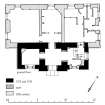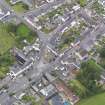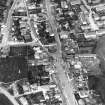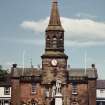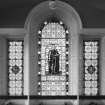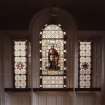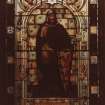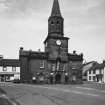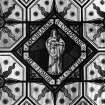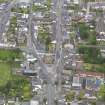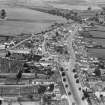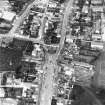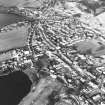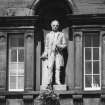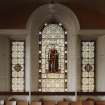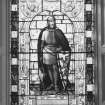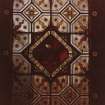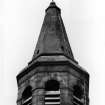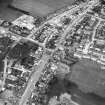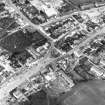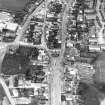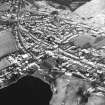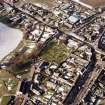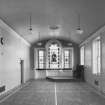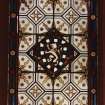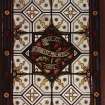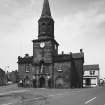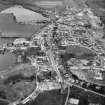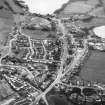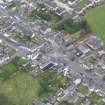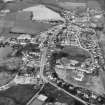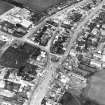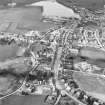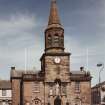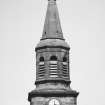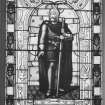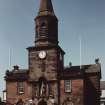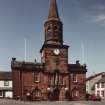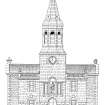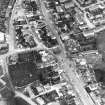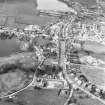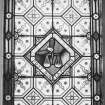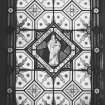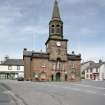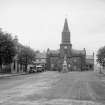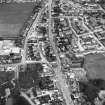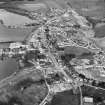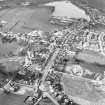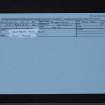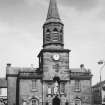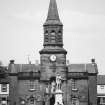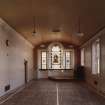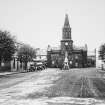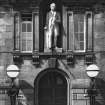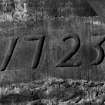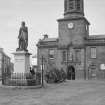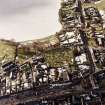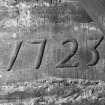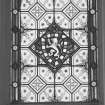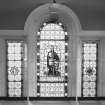Lochmaben, High Street, Town House
Tolbooth (18th Century)
Site Name Lochmaben, High Street, Town House
Classification Tolbooth (18th Century)
Alternative Name(s) Town Hall; Tolbooth
Canmore ID 66307
Site Number NY08SE 47
NGR NY 08181 82576
Datum OSGB36 - NGR
Permalink http://canmore.org.uk/site/66307
- Council Dumfries And Galloway
- Parish Lochmaben
- Former Region Dumfries And Galloway
- Former District Annandale And Eskdale
- Former County Dumfries-shire
NY08SE 47 08181 82576
Not to be confused with tolbooth of c. 1625, NY08SE 131.
Publication Account (1980)
Although G.S. Pryde claimed that there was a tollbooth at Lochmaben in 1563 (1950, 85), prisoners taken in Border conflicts were having to be lodged in the church during the reign of James VI (Twidale, n.d.,23). It appears that in 1612 and 1625 the king ordered a tolbooth to be built at Lochmaben stating clearly in the latter case that... the lower roumes may serve for prisons to malefactoures and the upper for keeping of courtis and administration of justice' (Wilson, 1974, 25). Money raised for the project went to a Perth bridge instead and no tolbooth was built. A tolbooth was erected in 1723 and a steeple was added through the benefaction of the Marquis of Annandale in 1743. It was described in 1840 as having a court house 1 in requisition chiefly by a dancing master for gala parties and below is a miserable jail of two apartments quite unfit for the lodgement and detention of a culprit' (Wilson, 1974, 26). The town hall was reconstructed and enlarged in 1869 (Wilson, 1974, 26).
Information from ‘Historic Lochmaben: The Archaeological Implications of Development’ (1980).
Publication Account (1996)
Situated on an island site at the N end of High Street, which forms a broad market-place, the town hall is a two-storeyed Tplan building with a steeple at the centre of the S front. This steeple was added in 1743 to a hip-roofed main block of 1723, comparable in scale to the existing one but with a central projection to the N, and part of the S wall of this block survives, including a 1723 date-stone. Except for the steeple, however, the building owes its present appearance to an extensive rebuilding in 1877, to the designs of David and John Bryce.
Before 1877 the steeple was flanked by two single-storeyed lean-to bays having open round-headed arches with projecting keystones and impost-bands, and known as the 'bows of the town hall'. In that year they were heightened to two storeys, surmounted by balustraded parapets, and their ground stages, with that of the steeple, were refaced with rusticated sandstone ashlar, the arches being infilled with windows. The roundarched entrance-doorway in the steeple was also renewed, as was the first-floor Venetian window whose central opening was altered to a niche which contains a statue of the Rev William Graham (d. 1887), a local benefactor. The square ashlar-built steeple rises to a heavy cornice below which there are four circular clock-faces. Above it there is an octagonal belfry rising from a plinth with concave sides. The belfry has louvred round-arched openings with keystones and impostbands, and below the cornice there is a raised band which on the S face bears the inscription 'Built by Ja(me)s Forrest 1743'. Above this a convex plinth carries a short octagonal spire, rising to a height of 22m.
The N block of 1877, which measures 16.5m from E-W by 7.6m, has a gabled roof and there are large Venetian windows in the E and W walls. Even where the early structure has been preserved the interior was heavily remodelled, and a staircase was formed in the bay E of the steeple in place of a forestair against the E wall of the original main block. Built into the N wall of the second-floor room in the steeple there is a panel bearing the date 1723. This is above the probable wallheadlevel of the building of that date, but it may have been incorporated in a central pediment or a bellcot (infra). The belfry contains a bell 0.5m in diameter at the mouth, which bears the inscription: EX DONO NOBILISSIMI CAROLI DUCIS QUEENSBERRY / ET DOVER 1757 W(ILLIA)M EVANS FECIT.
HISTORY
While there are references to a tolbooth at Lochmaben in 1563,3 it was stated in 1625 that the courts of the warden of the West March and the steward of Annandale had hitherto been held in the church. In that year James VI gave orders for his Master of Works to choose a site and build a tolbooth at Lochmaben, that 'the lower roumes may serve for prisons to male factoures and the upper for keeping of courtes and administration of justice'. The work was to be financed by fines imposed on inhabitants of the neighbouring sheriffdoms for illegal carrying of 'hagbuttes or pistolettes'. The 'toune court' was 'haldin in the tolbuith' in 1627.
In 1705 the Convention of Royal Burghs paid £100 Scots to the burgh 'for building and repairing the(i)r tolbuith'. Despite this, a new building was required by 1720, when minutes record 'the great loss the community of the Burgh is at through the want of a Tolbooth'. Subscriptions were raised from the inhabitants and from local landowners, and the datestone of 1723 presumably records the completion of the building in that year.
In 1741 the 3rd Marquis of Annandale presented £150 'for building a meall house and steeple' in accordance with a plan which had been in the possession of the town-council 'for somtyme past'. They decided to proceed with this, but to create a new doorway in the west gable of the town-house, giving access by 'a straight scaile stair' to the council chamber, and to remove the 'cupala' on its roof. The contract was awarded to Mr Henderson of Broadholm, for £150 and the value of the materials of the old staircase, cupola and town cross, and the James Forrest whose name appears on the belfry may have been a sub-contractor. The Edinburgh architect John Douglas may have had some involvement in the design, for an elevation-drawing attributed to him shows a tolbooth steeple whose lower stages and belfry are almost identical with those of the existing one.
The two open bays flanking the steeple were probably used for market purposes, and one of them served at some periods as a weigh-house, while the meal-market was probably on the ground floor of the main block, along with a shop which is first recorded in 1765, As well as the council-chamber, the building contained a town clerk's office, and two ground-floor rooms were used as a prison until 1844. Minor repairs were carried out in 1826 and 1839, but in 1870 it was decided to replace the main block. The designs by David and John Bryce were probably produced before the death of David Bryce in May 1876, but work began in February 1877 and the building was opened on the last day of that year.
Information from ‘Tolbooths and Town-Houses: Civic Architecture in Scotland to 1833’ (1996).









































































